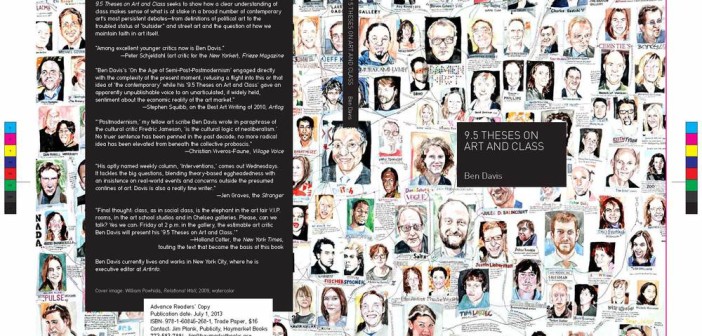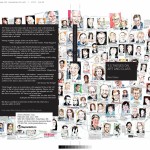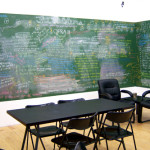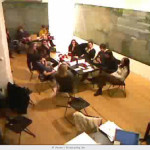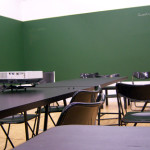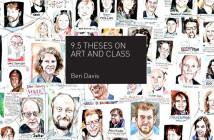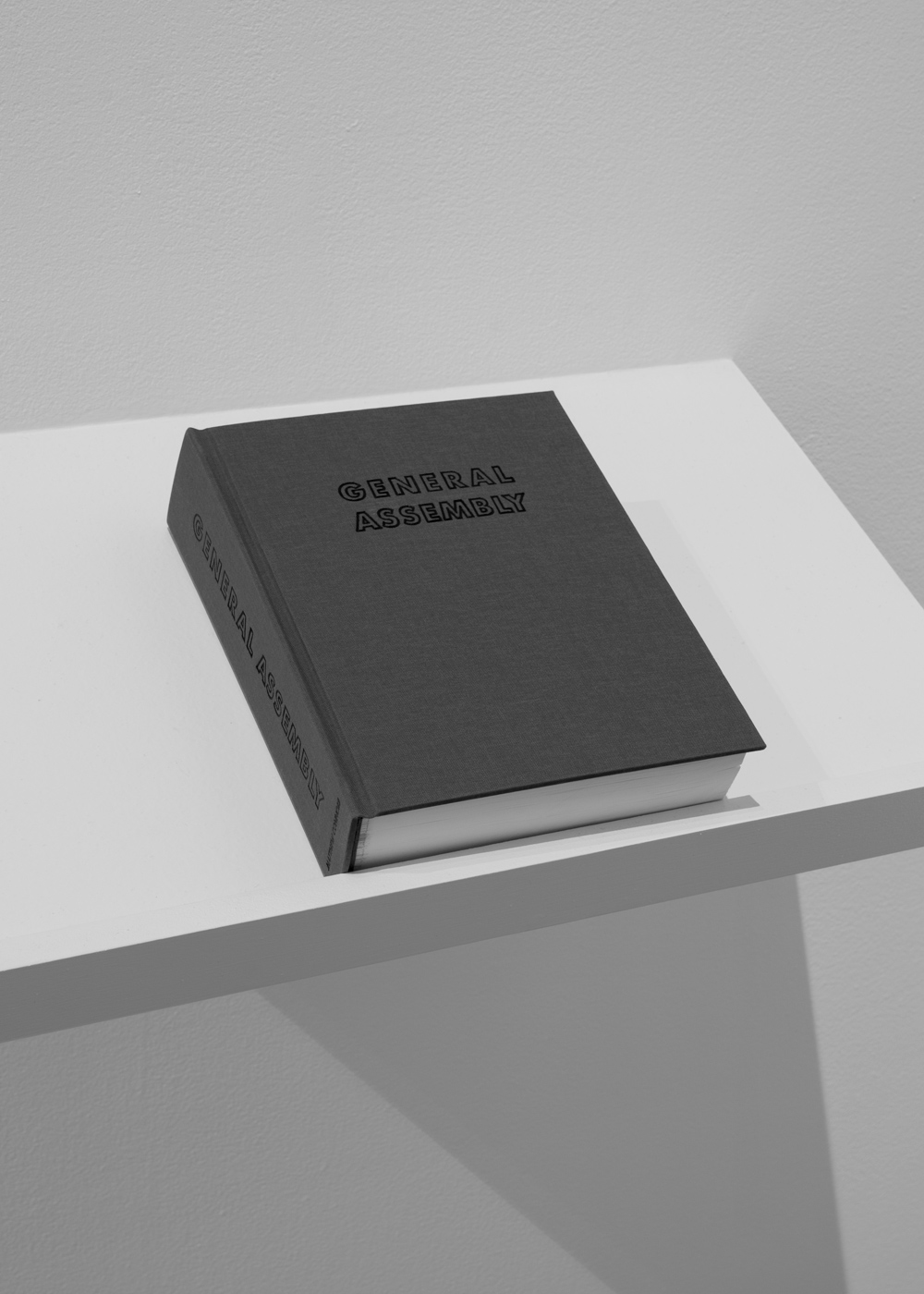Is there anything more invigorating than writing a response to the response to the response of a boldly political tract of Marxist art criticism? Such discourse is the lifeblood of a belief system that for a generation has little choice but to dwell in the suspended dream world of possibilities, sealed safely in the cultural sphere. We confine our thoughts to the fantasy of ideological formations while the brightest intellectual voices that came before us exposed these ideologies as such. Unreadable, unrelatable, and coded, it was the editor of the new left wing magazine Jacobin who recently compared leftist intellectual discourse to a deranged man publicly masturbating on the subway. Peddlers of the "insular and inconsequential" they "lack self-awareness about the timing or propriety of their actions, and they don’t see why that’s a problem."1
In 2010 Ben Davis wrote a pamphlet that ignited a different kind of class debate in the "art world." Wanting to correct the disorganized and clouded way artists were addressing inequality, Davis tackled the peculiar indulgences of the art system by taping his "9.5 Theses on Art and Class" to the door of Ed Winkleman’s Gallery. The pamphlet was part of #class, an exhibition curated by Jennifer Dalton and William Powhida in response to Dakis Joannou’s "Skin Fruit" show at the New Museum. Then, in the summer of 2013 Haymarket Press re-ignited the debate when it published a book length collection of Davis’s writing anchored by the eponymous text. In 16 essays, many published previously, Davis returned to the questions at the center of "9.5 Theses." The sprawling book did so with an insider’s knowledge but in a tone that welcomed politically committed outsiders looking for a "sympathetic guide to the strange fauna and flora of contemporary art."2 Meanwhile think pieces and reviews of 9.5 Theses on Art and Class continue to roll out in spite of our contemporary digital attention spans, a testament to the high stakes Davis erects, the erudition with which he navigates them, and the deeply entrenched positions taken among all parties.
For my own late dive into 9.5 Theses, I invoke the critic Daniel Mendelsohn who recently explained how he feels it is important to incorporate the reaction to a work before starting to write his own interpretation. Measuring the discourse seems all the more relevant in the case of 9.5 Theses, a populist series of texts that borders on the instructional. It is almost as if Davis, an incorrigible opponent of armchair socialists, prefers 9.5 Theses to generate this discourse on a much grander scale. And so it has.
Davis is an activist, a revolutionary who hasn’t quite given up. He resents the retreat into aesthetics of so many of his left leaning colleagues. Thus his time in the "art world" has been one of unrequited radical commitment. Like a reset button, Davis’s clear headed and direct diagnostic of the problems of the anti-septic art world try to convince us that in fact these problems transcend art itself.
What did Davis do to invite such ire, admiration, and debate? The book colors outside such Marxist lines, partly on purpose, to advocate a wholesale rethinking of art, artists, and political progress. One might look to Davis’s text as a revelation that a Marxist aesthetic—as we thought we knew it in the previous century—is an ultimately unattainable goal.
Rob Horning opened the critical debate with a close reading of Davis’s visions to remodel the inherent structures of artists’ production. Horning scrutinized the general claim that, as Horning interpreted it: "artists’ self-important claims for their work makes them worse than useless for political activism."3 Horning finds an apparent contradiction, asking how Davis is able to "protect the possibility of an idealized social function for art in the face of capitalist realities that deny it" and thus questions his defense of "the right of a select few to make a living through art."4
For Horning, under capitalism "artists make the satisfying feeling of being an artist as much as they make discrete artworks."5 While Davis starts out with a materialism that could lead to this point, his underlying desire would appear to be, in Horning’s words, a "generalized social practice . . . that can certify art’s value without somehow stratifying a society in which art has economic value."6 Horning challenges whether Davis really believes that "art institutions once served some pure notion of art and then somehow got corrupted?"7 Further "[w]hose ideal of purity would have been upheld?"8 Where Davis departs from Horning is the root of the surprising optimism of 9.5 Theses: Davis retains hopes for art only to the extent that they somehow might better accompany some sort of utopian program of social change, a maneuver that Horning is too analytical to permit.
Ultimately, however, Davis and Horning share a fundamentally similar outlook on the ideological underpinning of much contemporary art and literature. Horning’s indictment of the "nauseating" discourse that surrounds contemporary art aligns with Davis’s disdain for elitist jargon. For Horning "it deliberately aims to destroy the confidence of non-elite audiences in their own judgment," 9 whereas for Davis "insular" and "out-of-touch" "theory-crit" are silly "semantic games" that have no impact on "social organization or political strategy."
In September, an appraisal by Rachel Wetzler in Jacobin hit enough nerves to generate a response from Davis himself. While ultimately coming out as vaguely appreciative of the text, Wetzler continuously poked at the "scattershot rant about art-world idiocy."10 Trained as an academic, Wetzler perhaps also felt slighted by the lack of historicizing, setting up an astute point about the artist’s middle-class character with a lesson in the deeply historically contingent notions of the artist’s role in society.
For most of history, artists were essentially treated as a privileged type of artisan; the modern understanding of the artist develops in response to the transformed understanding of "work" and "skill" that accompanied the turn towards mechanized production, redefined in opposition to wage labor11
An idea that "emerges more or less alongside the second Industrial Revolution."
In a similarly academic mode, Wetzler took a dig at Davis’s pronounced anti-theory stance. His "lazy caricatures" of big name cultural theorists "tells us exactly nothing about why" they deserve ridicule.12 Davis’s oft quoted, almost poetic, takedown of leftist theorists was provocative, and it is a refrain repeated throughout the book. Though a committed Marxist activist, Ben Davis nonetheless wades into the current cultural left as if visiting Mars. 9.5 Theses on Art and Class will be remembered for many things, but perhaps its most enduring impact registers as an example of leftist thought that rejects much of the aestheticizing theory that has recently held sway.
Davis appears to be that rare person who has read the canonical theory though has nonetheless come out as "anti-theory." Asked about the misapplication of recent Marxist theory in a recent interview with The Brooklyn Rail, Davis states:
For Adorno and Horkheimer, for instance, the concept of class almost vanishes from their writing. Because the language of class and politics seems to have been hijacked, thinkers who are trying to come up with a progressive way forward deflect a lot of energy into artistic questions. So in my analysis, artistic questions become over-coded with political meaning, and at the same time, they become further and further removed from the central Marxist question of class and class struggle.13
Davis’s opposition to theory might also be related to his formative time spent writing under Walter Robinson, the avuncular editor of no-nonsense art journalism at artnet Magazine. Davis’s most lucid refutation of theory-crit may have come during summer of 2006, in his review of Rancière’s The Politics of Aesthetics for artnet:
Such an inability to call obscurantism as one sees it—the confusion of complex form with serious meaning—is, of course, an intellectual problem, leading to the substitution of quirky diction for critical thought. It is also, in this case, a political problem, in that it draws good people’s efforts into false intellectual debates. But it is, finally, an [a]esthetic problem as well. Failing to deal with such thought skeptically can only make the art world more insular, and more pompous.14
A central aspect of Art and Class is its aggressive anti-theory stance. Davis is a writer dealing with the broadly Marxist notion of class conflict while at the same time eschewing some of the major progressions of recent leftist thought. One response to the practical nature of Davis’s observations read it as a "sorely-needed dose of vulgar Marxism after decades of so-called ‘radical aesthetics.’"15 While it is hard to argue with the underlying spirit of Davis’s points about the poverty of some Marxist theory-crit, perhaps a more effective refutation of such theorists may have come from Davis working through these writer’s thoughts, on their own terms, picking at their supposedly faulty logic.
If there is a singular takeaway from the sprawling, interwoven essays, it is that Ben Davis is an activist. Activist logic is quite different from the presiding set of values and priorities of those enlightened few that inhabit the cultural field. Thus a major tension in Davis’s language more generally is rooted in this fact. One must consider whether Davis’s opposes "impenetrable theory" because of the paucity of its logic or because it simply lacks populist appeal.
When Davis considers the relationship of art to activism—or his charge that it has receded into the background—he is privileging a position in a knotty history of leftist cultural criticism. Davis could have done more to trace this history, and then engage the underpinnings of the artist’s tendentious position vis-à-vis politics instead of dismissing it on the grounds of practical ineffectiveness.
It is here and at other points throughout 9.5 Theses that his statements drift wholly away from the project of art theory and criticism—whatever it may be—into prognostications about its unsuitability with present leftist causes. One would be going too far if one were to draw parallels between Davis’s principles with the brief mid-century period of Soviet cultural policy known as Zhdanovism, a Stalinist program of pedagogical, politically-directed art which stated that art’s "petty-bourgeois dissoluteness and individualism" should be eradicated in favor of art as a weapon in socialist construction. Though routinely Davis plays with an opposition between art that is "gratuitous or even distracting because of its deliberately provocative moral ambiguity" and an art that has a "real position of practical consequence," a dichotomy that closely resembles the borders of the aesthetic questions that came out of the Stalin-Trotsky debates.16 For Davis these real, practical things are protests and direct action. Speaking derisively of the Situationists in ’68, "in a mass upheaval, graffiti hardly amounts to a strategy."17 And though he makes no pretenses about there being "an elegant fit between art and politics" nor an "ideal meld of the two," he does oppose a detached theory of a political-aesthetic that is divorced from the art work’s "significance to what is happening in the world."18 Though something of enduring political and aesthetic significance may later emerge, he counsels that "the need to engage comes first" and closes his thoughts by echoing Martha Rosler’s call to "organize, organize, organize."19
 The chaos that was 2010's chalkboard at #class at Winkleman Gallery.
The chaos that was 2010's chalkboard at #class at Winkleman Gallery."#class," organized by Jennifer Dalton and William Powhida. Courtesy Winkleman Gallery, New York."
Such a position also runs the risk (one that Davis recognizes) of throwing out the baby with the marginally-politically-committed-but-not-agitational-enough bath water. This sets up a frightening logical consequence: Will not all art look frivolous and ineffective next to organizing, agitation, and mass action? But alas there is no right answer here. And Davis is foremost in articulating this very fact, which is in itself a major service of the book. Though I would offer that this is among the most debatable points due to its downplaying of a form of Trotskyism that was slowly baked into late modernism. Davis knew he would have to ward off the charge of "vulgar Marxist," a notion tucked so deep in the left’s consciousness that its mere resurrection almost seems novel. Since as early as the 1960s, leftist intellectuals viewed cultural questions as fertile ground for their politics, a result of the unfortunate descent of the Soviet Union’s into totalitarianism. Davis would prefer the "Anti-culturization" of Marxist thought. And this might be the best way to understand many of his hard-edged positions. When he castigates the left’s aestheticizing of radical politics—"Just what exactly this ‘aesthetic revolution’ might look like or how artists working together might serve as a model for activism is left largely to the imagination"20—he refuses to acknowledge the role of the rich Trotskyite DNA within the accumulation of the artist’s position in the last century. Put more simply, Davis is most at issue with the extremes of Greenbergian formalism: that malformation of the Trotsky-Stalin debates that bled into the role of the modern artist in the construction of socialism. In fact, the crux of Davis’s argument about the fault lines in artist’s commitments to revolution are parallel to the then common charge against artists and intellectuals, they were mere "fellow travelers," dilettantish intellectuals who ignored the hard work of a building a worker state.
This is the form of Trotskyism that looked on from the sidelines, puzzled, as artists attempted to organize as laborers in the Vietnam era. In the 1930s, by contrast, the ideology of the Artist’s Union was more materially grounded in the production of art, namely the decoration of public buildings and the social or communicative service carried out by depictions of the American scene. Here Holger Cahill’s Whitmanesque and Deweyian theories of "Cultural Democracy" figured centrally. Socialist cultural thought also influenced the pre-history of New Deal’s support for artists, programs that were intertwined with the radical John Reed Clubs, the Stalinist New Masses, which eventually came to be implicated as a cultural Popular Front.
Herbert Read’s "What is Revolutionary Art?" (1935) is an archetypal text that presaged the slow embrace of Greenbergian formalism by the left. After witnessing the failure of the First Artists’ International, Read encouraged us to accept the abstract artists as the true revolutionary artists. At a nadir in the enthusiasm for abstraction among the left, Read defended art-for-art sake against the charge that it was "incomprehensible to the proletariat and of no use to the revolutionary movement."21 "Like the simple bourgeois of another generation," the opponents of a free abstract art "ask for something they can understand, a ‘realistic’ art above all, something they can use as propaganda."22
Read noted that a Marxist view of history should recognize that it is through "style and mannerism that the prevailing ideology of a period is expressed."23 The historical context in which Read reasoned was key: the socialist state was ascendant and the bourgeois ideologies—past western philosophy, religion, and culture—were viewed as a remaining obstacle. This is how he determined that abstract art has a positive function that preserves the universal qualities of art, its forms in pure states, for the post-socialist world. This was the revolutionary function of the formalism of Mondrian, Barbara Hepworth, Brancusi, and so on. He summarizes "What is Revolutionary Art" by stating that "this single link points the way to the art of the future: The art of the new classless society."24 Communists want something tougher than mere folky peasant art, "something more intellectual and difficult, and something that we can without falsity and self-deception put beside the great epochs of art in the past."25
In Meyer Schapiro’s "The Social Bases of Art" (1936) the popular radical critic called for artists to form an alliance with the proletariat and to reject the false individualism of the detached artist. Merely a year later his "Nature of Abstract Art" was a watershed moment in the negotiation of the disinterestedness of the artist’s position in the face of formalism. In "Nature of Abstract Art," Schapiro reversed his position lending currency to a sort of Trotskyite position of an avant-garde abstract art. Schapiro’s rhetoric provided a powerful link between abstraction and the social conditions from which it arose. Some perplexed responses to Davis could be tucked under 9.5 Theses’ reluctance to treat such a formalist discourse at face value, as this was more than enough for the high modernists who would continue to make individualistic or expressionist art while remaining tied to a broad leftist cause.
This brief and incomplete historical sketch of the first attempts of American artists to organize in the 1930s serves only to underscore the vastly complicated series of intellectual twists and turns that have been taken during and the since the Cold War. It is in this ahistorical mode that partly contributes to the complexity of the book. Yet one could argue the opposing point: that a historicized re-construction of the artist’s role in society is likewise helplessly confusing and contradictory. One can’t help but wonder if Davis’s lack of engagement with the layers of meaning inherent in the recent history of the politically engaged artist is a symptom of his total disenchantment with the modernist project. (It’s certainly not due to his ignorance of its source material).
This is one of the reasons, paradoxically, that Davis makes such an effective critic more generally. His plainspoken, systematic, nearly populist concerns do not obviate his thirst for some type of political relations for art. Yet instead of the tortuous historicizing normal in such discourse, Davis does a hard reset, representing an interesting breaking point in leftist thought.
There is an unbreakable rule that all discussions of Marxist criticism must feature an aside consisting of quotes from a canonical figure that compares their views to the issue at hand. This serves as a critical tool that historicizes the subject in question, situates the text in an artificial camp on either side of a manufactured debate, and last and most importantly, establishes the credentials of the present author. There are few things are more delicate than the ego of the male Marxist intellectual. This sort of writing is of little to use to anyone unless they are preparing for an upcoming Party meeting, and yet they continue to be written. For my token dead white male exegesis, I have selected Georg Lukács because he provides an interesting example of some of the more enigmatic aspects of high Marxist aesthetic theory.
Lenin’s reflection theory—roughly, that art was a reflection of reality, a mirror to the artist’s part in historical progress—weighed heavily on Lukács, as did Marx and Engels general Base-Superstructure doctrine, wherein the material base of society conditions the superstructure of art, religion, law, et cetera.
 Still of a live webcast from #class.
Still of a live webcast from #class."#class," organized by Jennifer Dalton and William Powhida. Courtesy Winkleman Gallery, New York."
In The Historical Novel, Lukács stated, "what Marx said of legal institutions applies in wide measure to literary forms. They cannot stand higher than the society which brought them forth."26 Yet at a time when Socialist thinkers needed to use polemic to ascribe a negative outcome to non-proletarian art, they fell into the practice of citing a certain practice as "slippery slopes" to fascism (as if art ideologically prepares coming developments in history). Such a doctrine renders contradictory any attempts by Marxist theoreticians to blame artists for subsequent deformations. Thus is certain cases, much of an artist’s political agency is eroded; art’s "active" role in bringing about classless society is weakened. The Marxist critic can turn to the artist to diagnose the ways in which his or her work is a reflection of the perversions in capitalist society, but must retain a passive, ex post facto relationship among the two. Thus the official Marxist thought that deals with questions of the ideal route for art always must perform a dialectical meld by choosing a side. For Maynard Solomon, writing in the 1970s, art’s position varies according to conflicting stakes of Marxist theories of art:
Art simultaneously reflects and transcends; says "Yes" and cries "No;" is created by history and creates history; points toward the future by reference to the past and by liberation of the latent tendencies of the present. Marxism is concerned with the trajectory of art as well as with its sources.27
Here Davis presents an intersection. He often describes the abuses of the art world as reflections of the class rule inherent in capitalism. Little of what Davis has to say weighs in on the relationship between object and subject that normally preoccupies aesthetic theorists. And, this makes sense given Davis’s underlying belief that in most cases artists are imperfect messengers of political progress or collective consciousness—"because of its middle-class character, it has relatively little actual effective social power."28 The ending of his chapter on "Art and Inequality" is, I think, indicative of this in that he deflects any predictions about art "buoyed" and "distorted" by neo-liberalism in favor of using his analysis as a new, clear "roadmap" of the contested territory.29
There are all types of "Marxisms," especially today. Davis seems to have arrived at his Marxism through activism, and not, as it were, the other way around. His relationship to art is at once political and idealist. Challenging the merits of Davis’s Marxism is not the point—to the extent that one would even waste energy on such a trivial gesture when there is literally nothing at stake. Rather I think Davis achieves a new sort of radicalism in the non-Marxism of his Marxist positions. Depending on whom you ask, this is either refreshing or vulgar, because the ways in which he blasts past recent theory illustrates his strong belief that art and artists make unreliable vessels for social change.
Lukács, writing in 1962 and referring to the follies of his much earlier Theory of the Novel, stated that "[I] was not looking for a new literary form but, quite explicitly, for a ‘new world.’"30 It is the "utopian" critic who strives for a new world via art when in fact what they want is a new world for art. Davis is highly critical of the Utopian strain of socialism, and in "Collective Delusions" describes them as those who "saw their job not as participating in collective political struggle but in drawing up attractive and imaginative plans for harmonious future communities."31 As Davis continues to paint the picture of the Utopians we get a clearer picture at his frustrations with the non-committal gestures of artists; they see the "agent of change not in the masses themselves, but in the minority who could dream up a plan" in "the rich and powerful people who would fund and enable them to realize their egalitarian fantasies."32 In discussing the political efforts of collectivist artists, Davis draws up a one way street for art in his appeal to orthodox Marxism: "to be fully meaningful, collective social life requires an actual political revolution, which only subsequently creates the space for authentically collective experience, a process that won’t be short-circuited by any intellectual means."33
Still, it would be a mistake to finish 9.5 Theses and not grasp Davis’s specific recommendations for a more equitable art world. In fact theses 8.1 through 8.9 are specific objectives for reforms, culminating in the call for creativity to be "redefined" as a "basic human need."34 It is through this route that, for example, that such reforms will link up with "struggles outside of the sphere of the visual arts."35
In the aptly named final chapter "To The Future," a cohesive picture of art is rendered not by specific aesthetic values but by Davis reimagining its future position in a far off society where creativity is liberated from "privilege", "professionalism", and of course the neoliberal luxury industry, and is instead art in the broadest Marxist sense of un-alienated labor, where art "feels truly part of the present and not removed from it."
In staking out a claim for art, Davis covers much ground. His call for a "really existing" aesthetic politics is a departure for many. But is Davis’s logic just a response to the morphology of Marxism under networked capitalism? His refutation of neo-Marxist shibboleths is so heretical, so outsider, that it erases most leftist pedagogy. In the face of the glib incantations of Occupy Wall Street Davis’s chapter-and-verse Marx is almost intellectually vanguard.
For Davis artists are middle class because their career success is significantly intertwined with their own personal intellectual success, unlike the wage laborer and the alienated white-collar worker. Personal fulfillment and professional ambition overlap, in what Davis characterizes as the classic "middle-class aspiration."36 Davis moves through this idea on varying levels, but his central point is that "artists ha[ve]weak relations with the working class."37 This is a material condition in which they have an individualized relation to their labor: these middle-class agents "tend to conceive of their ability to achieve their political objectives in individualistic terms, with their social power deriving from intellectual capacity, personality, or rhetoric."39 Indeed, in theory and often in practice, they have a nearly unmatched influence over creative choices about their work.
But why put artists in a class based on their relations as producers? It is only recently that artists produced work in a field with a robust and open market for it. Such a perspective on artists’ class has its intellectual birth after Modernism. Any debate that considers their material production as labor could have only arisen after the rise of the market for living artists and the associated challenges to the academy’s ability to temper taste and production. The charge of being "middle class" met disdain from artists themselves, whom felt unfairly trapped by between bohemian myth, professional education, and a hit-or-miss market for their work. Though in the end, Davis’s most contentious position does more harm than good, as it injects realism into the almost ecclesiastical criteria with which the "art world" venerates artists who might harbor weak or mendacious claims to Marxist, or even liberal politics.
Yet to the extent that Davis was going for a well-formed aesthetic theory—and he may not have been in the traditional sense—his ideas about art are much closer to John Dewey than anything under the Marxist sun. While his end goal is surely a classless society brought about socialist reorganization, his findings about art follows allow Deweyian lines of social "experience." To wit, in order to understand the meaning of artistic products, Dewey asks us to "forget them for a time" and to "turn aside from them and have recourse to ordinary forces and conditions of experience that we do not usually regard as [a]esthetic."39 In ideology and tone, the following passage from Dewey’s widely read "Art as Experience" could have been in any part of 9.5 Theses and it would have done much to support and advance its claims:
By common consent the Parthenon is a great work of art. Yet it has esthetic standing only as the work becomes an experience for a human being. And, if one is to go beyond personal enjoyment into the formation of a theory about that large republic art of which the building is one member, one has to be willing at some point in his reflections to turn from it to the bustling, arguing, acutely sensitive Athenian citizens, with civic sense identified with a civic religion of whose experience the temple was an expression, and who built it not as a work of art but as a civic commemoration.40
Dewey’s thoughts on aesthetic theory of his day likewise mirror Davis’s opposition to the root obscurantism of "theory-crit:" Dewey wrote: "[w]hen artistic objects are separated from both conditions of origin and operation in experience, a wall is built around them that renders almost opaque their general significance, with which esthetic theory deals."41
Somewhat along these same lines lies Davis’s last and most transcendent request: that we rethink creativity is a fundamental aspect of the human experience, and not as an attribute to be monopolized by any professional category or historically contingent definition of a special segment of the population, namely artists.
Davis’s position on creativity is logical and clear, though somehow morally tinged. One can only disagree with it by appealing to the social distinctions that construct the alloyed nature of the artist’s privileged position, those contradictions that are themselves lynchpins of much leftist art historiography. In one of the earliest reviews of Art and Class Rob Horning notes this incongruence:
Even as he convincingly argues that there are "different class-based notions of creative labor" and that "one must judge art in terms of the contradictory values given to it by competing class interests," he is ready nonetheless to tout a universal ideal of "creative expression" and assert that art has some objective value that could be deduced in the abstract, independent of the class struggle that everywhere else determines the relative value of human effort.42
The irreconcilable piece of a Marxist theory of art, to the extent that that is what Davis is after, flows from the very terms that open the debate. Unsurprisingly, Marx and Davis are near identical in their separation of "art" from "art production."
Art was for Marx something that was free of any social purpose, much in the Kantian tradition of a disinterested aesthetic experience. Yet Marx and most all of his followers, even today, group art under that vast cloud of "ideology." O. K. Werckmeister captures this essence perfectly in an essay from 1973: Ideologies, the "fog formations in the brains of men", are "made to appear autonomous in relation to the primary, material production of life, while in fact serving its social organization."43
 The mostly empty chalkboard at #class, so filled with potential.
The mostly empty chalkboard at #class, so filled with potential."#class," organized by Jennifer Dalton and William Powhida. Courtesy Winkleman Gallery, New York."
For Marx, too, "art" was related directly to humanity and creativity, while art production is debased by the ever more alienating effects of capitalism. Art production will always be painfully distanced from the historical ideal upon which its idea was based. In other words, "art production" as wrought from the realm of "art" can now only be an object of historical contemplation, where dreams of emancipation never catch up to the ideals from which art lapsed. All art making is alienated activity. After the Classical period, "art" always really implies "art as it exists in its relationship to economic basis of society." Davis reanimates the call to make clear the ways in which the artist adjusts to the material conditions of society, but his conclusion takes a different turn. One might make an entire career of Marxist critical practice by pointing out all the instances in which art making deviates from the western ideal of art as an idea. Yet in Davis’s view this type of discourse led to the very "superficial engagements" and "theory speak" that moved us away from "real" change.
What used to be contained between the lines of dense theory is now plainly indicted: "We begin to see that making the distinction between art in its narrow sense and art in its broad sense is already political, in that it forces us to interrogate the conditions that create this separation that confines our aspirations for our creative selves to one particular niche career."44 Instead of layering on the "political aesthetic" and perpetuating the myth of the Cold War-berthed Greenbergian formalism, he maintains that the question of emancipation perhaps does not begin with art at all.
It is no surprise, then, that for Davis the notion of the "art world" is a morally questionable and false construction since it serves to obfuscate class relations that permeate its supposed boundaries. Davis helps us understand how people that live, work, and think in the art world are quite possibly engaging in the milieu most deeply informed by demarcations of class boundaries. Consider that one’s intellectual engagement with modern art is in almost all cases somehow traceable to a discourse the emanated from the "ivory tower" where a disinterested class of persons are able to dedicate time to contemplating the subtle brushstrokes of Matisse in a world removed from the realities of economic subjugation. Davis knows this and uses it as direct call to action, a radical action involving our re-valuation of creativity. To separate out "art" as the coded, historically contingent ideology and "art" as broader concept.
In The German Ideology (1846), Marx points out the differences between Raphael and the artists under communism. Unlike the Renaissance master who "was conditioned by the technical advances of art which had been made before him" and "the organization of society and the division of labor," in a communist society "there are no painters, but at most men who, among other things, also paint." Here is Davis’s position:
On the one hand, ‘art’ might refer to the products of human creativity in general . . . On the other hand, the term "art" points us to domain of "visual artists," a professional classification . . . Commentators who wax poetic about the importance of art routinely confuse these two senses, letting art in the narrow sense usurp the status of representing creativity in general.45
Despite the dreams of the Cold War theorists, post-Frankfurt School thinkers, and generally postmodern artistic practices, we cannot have a "Marxist aesthetic" as laid out by the previous century’s canonical thinkers. How can we make progress towards a sound aesthetic according to Marxian lines when, as Davis quotes theorist Terry Eagleton, Marx’s view was that we "only genuinely produce when they do so freely and for its own sake"?46
As Davis puts to rest some of the less than useful theoretical tools of an untidy Marxist century, suddenly the confusions and false starts of "political artists" start to seem inevitable. And Davis’s protestations about the ineffectiveness of such practice leave the realm of a frustrated activist and become part of a larger monolithic paradox of "art as a weapon" in the class struggle. Davis helps point to the "ever-more tortuous forms" that our pretentions take in order to sustain the idea that artists are still the "leading innovators of culture."47 Even after such a desecrated state of leftist affairs, we may in fact have a new mission for aesthetics in the form of a revived Marxist criticism, in that the critic will not hold out for a modernist teleology, or be our Greenbergian guide to a new cultural socialism devoid of Kitsch, but instead the critic, following Davis’s lead, will ease us out of the fetishism that lead us to the logic of a painfully contingent and rarefied "art world."
- Book cover for Ben Davis’s 9.5 Theses on Art and Class. Cover image: William Powhida, Relational Wall, 2009, watercolor.
- The chaos that was 2010’s chalkboard at #class at Winkleman Gallery. “#class,” organized by Jennifer Dalton and William Powhida. Courtesy Winkleman Gallery, New York.”
- Still of a live webcast from #class. “#class,” organized by Jennifer Dalton and William Powhida. Courtesy Winkleman Gallery, New York.”
- The mostly empty chalkboard at #class, so filled with potential. “#class,” organized by Jennifer Dalton and William Powhida. Courtesy Winkleman Gallery, New York.”
[1] Sunkara, Bhaskar, "Fellow Travelers," Jacobin 10. https://www.jacobinmag.com/2013/04/fellow-travelers/
[2] Davis, Ben, 9.5 Theses on Art and Class (Chicago: Haymarket, 2013), 4
[3] Horning, Rob, "Creative Tyranny," The New Inquiry 19 (2013) p 72
[4] Ibid. 73
[5] Ibid. 69
[6] Ibid. 74
[7] Ibid. 74
[8] Ibid. 74
[9] Horning, Creative Tyranny, 70
[10] Wetzler, Rachel. "Art Class," Jacobin. Online. September, 2013. https://www.jacobinmag.com/2013/09/art-class/
[11] Ibid.
[12] Ibid.
[13] Ben Davis interviewed by Wendy Vogel, "Ben Davis with Wendy Vogel," The Brooklyn Rail, October 2013
[14] Davis, Ben. "RANCIÈRE, FOR DUMMIES," Artnet Magazine. Online. August, 2006. http://www.artnet.com/magazineus/books/davis/davis8-17-06.asp
[15] Wolfe, Ross. "Art and Politics in Class Society," The GC Advocate, December, 2013. http://opencuny.org/gcadvocate/2013/12/01/art-and-politics-in-class-society/
[16] Davis, 9.5 Theses on Art and Class , 47
[17] Ibid. 72
[18] Ibid. 58
[19] Ibid. 49
[20] Ibid. 52
[21] Read, Herbert, "What is Revolutionary Art?" in Modern Art and Modernism: A Critical Anthology, ed. Francis Frascina and Charles Harrison (New York: Harper & Row Publishers, 1982), 123.
[22] Ibid. 123
[23] Ibid. 124
[24] Ibid. 126
[25] Ibid. 127
[26] "Georg Lukács" in Marxism and Art: Essays Classic and Contemporary ed. Maynard Solomon (New York: Alfred A. Knopf, 1973), 389
[27] Ibid. 18
[28] Davis, 9.5 Theses on Art and Class, 45
[29] Ibid.106
[30] Originally from Lukács, Georg, The Theory of the Novel. A Historico-philosophical essay on the forms of great epic literature, translated from the German by Anna Bostock (Merlin Press, 1978) accessed online via http://www.marxists.org/archive/lukacs/works/theory-novel/preface.htm
[31] Ibid. 67
[32] Davis, 9.5 Theses on Art and Class, p. 67
[33] Ibid. 70
[34] Ibid. 44-45
[35] Ibid. 45
[36] Ibid. 177
[37] Ibid. 29
[39] Ibid. 30
[39] Dewey, John. Art as Experience (New York: Pergiee, 1980), 4
[40] Ibid. 4
[41] Dewey, Art as Experience, 3
[42] Horning, Rob, "Creative Tyranny," The New Inquiry 19 (2013) p 72
[43] Werckmeister, O.K. "Marx on Ideology and Art," New Literary History, Vol. 4, No. 3, Ideology and Literature. (Spring, 1973) p 505
[44] Davis, 9.5. Theses, 214
[45] Ibid. 177
[46] Ibid. 216
[47] Ibid. 178

